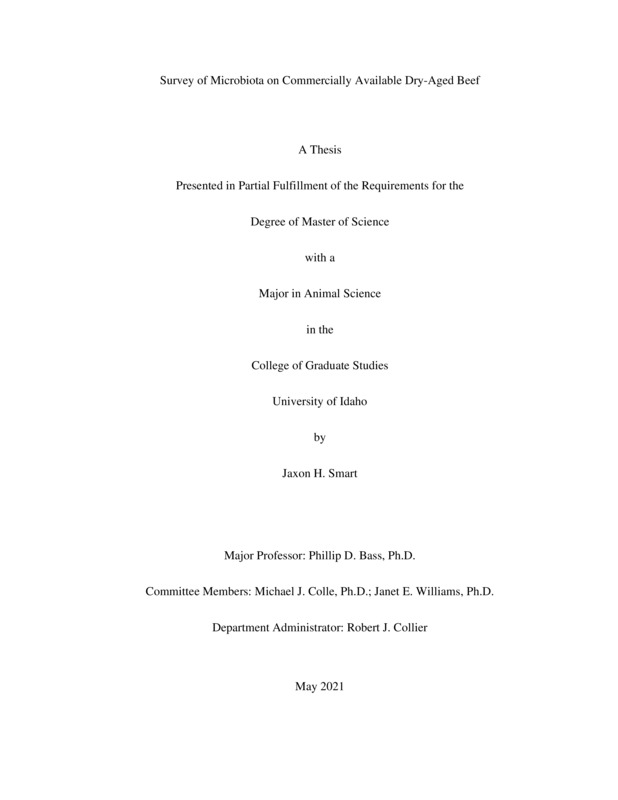Survey of Microbiota on commercially available Dry-Aged Beef
Smart, Jaxon. (2021-05). Survey of Microbiota on commercially available Dry-Aged Beef. Theses and Dissertations Collection, University of Idaho Library Digital Collections. https://www.lib.uidaho.edu/digital/etd/items/smart_idaho_0089n_12099.html
- Title:
- Survey of Microbiota on commercially available Dry-Aged Beef
- Author:
- Smart, Jaxon
- Date:
- 2021-05
- Program:
- Animal and Veterinary Science
- Subject Category:
- Animal sciences
- Abstract:
-
Dry-aging is the process of holding meat for extended periods of time, in a refrigerated system, without protective packaging thus exposing the meat to all environment factors within that system. One of those factors is the presences of bacterial and fungal organisms, which may contribute to development of unique flavors observed in dry-aged products. It is commonly believed among meat specialist and butchers that mold growth contributes to the many unique flavors associated with dry-aged beef. The objective of this thesis is to identify microbial populations, bacterial and fungal, found on wet and dry-aged strips loins from commercial dry-aging facilities and access the potential influence of eating quality they may have on dry-aged beef. Beef bone-in strip loins (N = 60) were dry-aged at 10 commercial dry-aging facilities for 45 days. Six strip loins were also wet-aged as a control at the same time. Following the 45-day aging period, 200 milligrams of surface crust were aseptically removed from each strip loin prior to DNA extraction. The 16S rRNA gene (bacteria) and the ITS1 domain (fungi) were amplified using a targeted polymerase chain reaction (PCR) for each sample. Sample amplicons were then cleaned, quantified, pooled and sequenced using a paired-end 300 base-pair protocol for 600 cycles on an Illumina MiSeq sequencing platform. Sequencing data were analyzed in R version 3.6.1; taxonomy was assigned using the SILVA 16S rRNA version 138 (bacteria) and the UNITE version 8.2 (fungi). Relative abundances of taxa were then calculated to characterize the respective microbial communities by location. Microbial DNA was found at all locations, including locations using UV light. Microbial communities, bacterial and fungal, were unique and complex for each dry-aging facility. The organisms observed are commonly thought of as meat spoilage organism. However, the presence of some organisms of these organisms may be beneficial to the dry-aging process observed.
- Description:
- masters, M.S., Animal and Veterinary Science -- University of Idaho - College of Graduate Studies, 2021-05
- Major Professor:
- Bass, Phillip D
- Committee:
- Colle, Michael J; Williams, Janet E
- Defense Date:
- 2021-05
- Identifier:
- Smart_idaho_0089N_12099
- Type:
- Text
- Format Original:
- Format:
- application/pdf
- Rights:
- In Copyright - Educational Use Permitted. For more information, please contact University of Idaho Library Special Collections and Archives Department at libspec@uidaho.edu.
- Standardized Rights:
- http://rightsstatements.org/vocab/InC-EDU/1.0/

